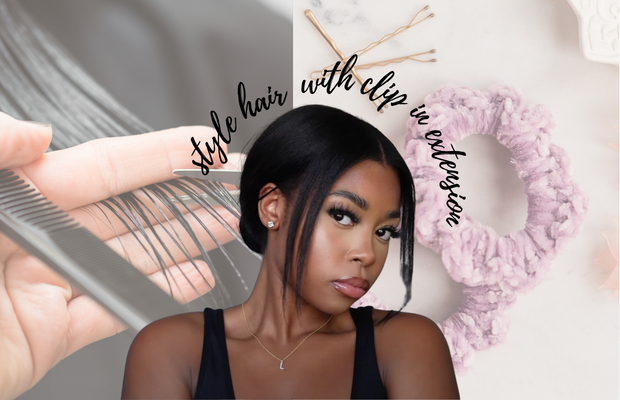̀̀̀5 Different Types Of Hair Extensions: Which Is For You?
Have you heard of fusion, microlinks, pre-bonded, weaves, or tape-ins? There are so many various types of hair extensions that beginners may become confused when hearing the phrases for the first time. In this guide, we'll look at the many types of hair extensions and the differences between human hair weaves and synthetic ones.
1 - Clip-In Hair Extensions
Clip-in hair extensions are a type of weft hair with clips sewed to the root of one side. Clip-in hair extensions are classified into two varieties based on the substance used: synthetic clip-ins and human hair clip-ins. Both of them are really useful for increasing the length and volume of your hair.
Clip-ins are often faster to apply than other forms of extensions. Furthermore, because no pressure, heat, or chemicals are used during the implantation process, these extensions do not harm natural hair. Even though there are various types of hair extensions available on the market, clip-in extensions are the finest option.
Who should use clip-in hair extensions? Clip-in hair extensions are suitable for all individuals. However, if you have short hair, it can be tough to disguise the clips. Request that your hairstylist blend clip-in hair extensions with your natural hair.
Tape-in hair extensions are a form of semi-permanent hair extension technique that is pre-taped with medical-grade glue. It can be manufactured from either fiber strands or real human hair. During the installation process, you must tape or glue it together on both sides of the natural hair.
When it comes to applying tape-in hair extensions, your hairstylist must utilize heating tools to connect them to your natural hair. Although the high heat can damage your natural hair, tape-in hair extensions are incredibly comfortable to wear on a regular basis. If I have to use a hair extension to add length, it will be tape-in.
The hairdresser apply the extensions by heating the adhesive using a heated instrument. Furthermore, use a glue remover before removing them. When heat is given to your roots, including the adhesive, there is a considerable risk of badly destroying your natural hair. If the extensions are in good shape, you can apply them in 40 minutes.
How long does this last? Tape-in will appear best for the first 4-5 weeks, as your natural hair grows around an inch longer. The tape-in extensions are tightly bonded to your hair, making it impossible to remove them. However, if I have to use a hair extension to boost length, it will be tape-in.
3 - Sew-In Hair Extensions
Sew-in hair extensions attach weft hair directly to your own hair. You must braid cornrows before applying the weave hair, using a needle and thread to sew them into the braid. Weaves are only suitable for women with thicker hair because they are put in a specific way.
If you get your sew-in hair extensions done by a skilled hair stylist, they will seem quite real. Sew-in extensions, unlike separate wefts, are made up of a single piece. Many women choose these sorts of extensions since they are smooth and permanent. After sewing them in, these extensions cannot be removed unless the natural hair grows long enough or you cut them off.
On the other side, you must go through a lengthy weave application process, which might last several hours. Most women feel incredibly uncomfortable and heavy since the application technique causes tension on their scalps. If you have thin or light hair, sew-in hair extensions are not a smart choice.
Fusion hair extensions are a popular way to transform your hair. Hairdressers utilize glue or another adhesive to attach the pre-bonded extensions to the natural hair.
If you don't want to spend a lot of money on your hair but still want it to seem thick and bouncy, fusion hair extensions are the perfect option. It is comfy to wear for a long period. You will not feel any tension or pain if they are installed by expert stylists.
However, the application procedure takes longer than three hours. Because fusion extensions can cause hair damage, certain women with damaged or fragile hair should avoid using them.
Several hairdressers suggest that there are better alternatives to this procedure. To apply the extensions, use a hot glue gun that may attach them to individual strands of actual hair.
Other names for these extensions include micro loop and micro bead hair extensions. In natural hair, you must identify small portions to attach tiny wefts of hair using a little silicone-lined bead. To secure the bead to the hair, use a specific tool to tighten the hold of the extensions.
The major reason ladies love microbeads is their lengthy lifespan. Can you believe that microlink hair extensions can last up to ten weeks? Yes, they do. Furthermore, if you take good care of them, they can be reused 5-6 times.
Even if heat and glue are not utilized during the installation process, these types of extensions can cause harm to the hair by putting pressure and pushing on the roots. Normally, the application procedure takes more than two hours.
There are various aspects to consider while selecting a good type of hair extension. The most significant elements are your hair's length and thickness. If you have long hair, you can use any sort of hair extension. However, if your hair is shorter than 10 inches in length, you should avoid using clip-in or tape-in extensions. Your hair's thickness is quite significant in hiding the extensions. While high-density hair will seem natural with all types of extensions, women with thin hair should use sew-in extensions to add length and thickness to their hair.
Conclusion
We hope you now know what the many types of hair extensions are. Before investing in a hair extension, consider the application technique and the risk of hair damage. In general, human hair extensions are the best and can last for more than a year.









Comments
Post a Comment